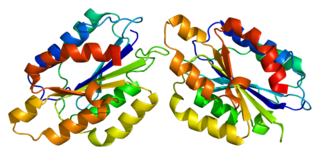
CD8 is a transmembrane glycoprotein that serves as a co-receptor for the T cell receptor (TCR). Like the TCR, CD8 binds to a major histocompatibility complex (MHC) molecule, but is specific for the class I MHC protein. There are two isoforms of the protein, alpha and beta, each encoded by a different gene. In humans, both genes are located on chromosome 2 in position 2p12.

CD11c, also known as Integrin, alpha X (ITGAX), is a gene that encodes for CD11c.
The ERRs are orphan nuclear receptors, meaning the identity of their endogenous ligand has yet to be unambiguously determined. They are named because of sequence homology with estrogen receptors, but do not appear to bind estrogens or other tested steroid hormones.

CD49a is an integrin alpha subunit. It makes up half of the α1β1 integrin duplex.

Integrin alpha-3 is a protein that in humans is encoded by the ITGA3 gene. ITGA3 is an integrin alpha subunit. Together with beta-1 subunit, it makes up half of the α3β1 integrin duplex that plays a role in neural migration and corticogenesis, acted upon by such factors as netrin-1 and reelin.

Interleukin 6 receptor (IL6R) also known as CD126 is a type I cytokine receptor.

Integrin alpha-5 is a protein that in humans is encoded by the ITGA5 gene.

Interferon-alpha/beta receptor beta chain is a protein that in humans is encoded by the IFNAR2 gene.

Chemokine receptor 6 also known as CCR6 is a CC chemokine receptor protein which in humans is encoded by the CCR6 gene. CCR6 has also recently been designated CD196.

The alpha-1B adrenergic receptor, also known as ADRA1B, is an alpha-1 adrenergic receptor, and also denotes the human gene encoding it.

The alpha-1D adrenergic receptor, also known as ADRA1D, is an alpha-1 adrenergic receptor, and also denotes the human gene encoding it.

Retinoic acid receptor gamma (RXR-gamma), also known as NR2B3 is a nuclear receptor that in humans is encoded by the RXRG gene.

Neuronal acetylcholine receptor subunit alpha-7, also known as nAChRα7, is a protein that in humans is encoded by the CHRNA7 gene. The protein encoded by this gene is a subunit of certain nicotinic acetylcholine receptors (nAchR).

Chemokine-binding protein 2 is a protein that in humans is encoded by the CCBP2 gene.

Neuronal acetylcholine receptor subunit beta-4 is a protein that in humans is encoded by the CHRNB4 gene.

Interleukin 11 receptor, alpha subunit is a subunit of the interleukin 11 receptor. IL11RA is its human gene.

Olfactory receptor 10G3 is a protein that in humans is encoded by the OR10G3 gene.

Neuronal acetylcholine receptor subunit alpha-9, also known as nAChRα9, is a protein that in humans is encoded by the CHRNA9 gene. The protein encoded by this gene is a subunit of certain nicotinic acetylcholine receptors (nAchR).

Interleukin 3 receptor, alpha (IL3RA), also known as CD123, is a human gene.
T-cell receptor alpha locus is a protein that in humans is encoded by the TRA gene, also known as TCRA or TRA@. It contributes the alpha chain to the larger TCR protein.


















